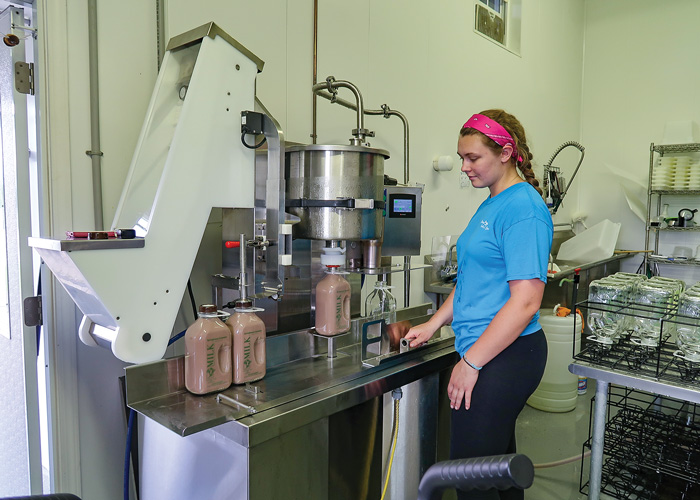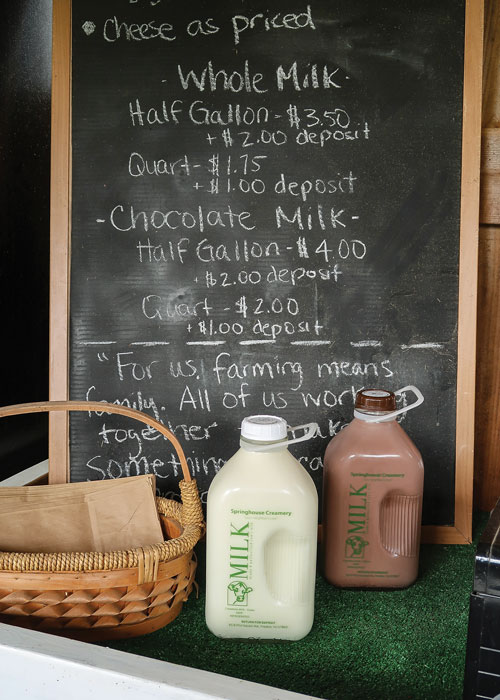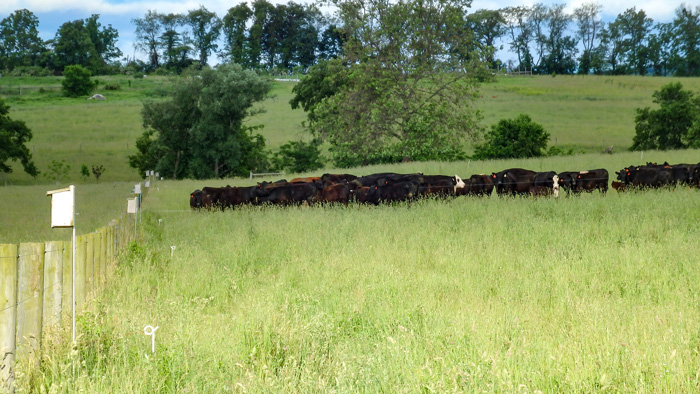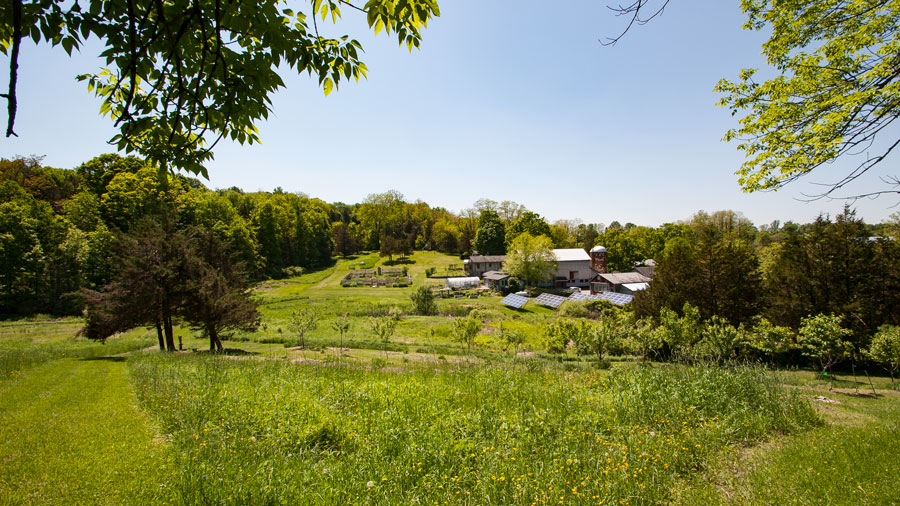Northwest New Jersey is now home to two dairy farmers who sell their milk directly to the consumer. It may not seem like much, but it is an important step forward in developing a more direct relationship between food and farm. Or is it an important step back, to days when food didn’t come from the supermarket shelves?

Just over one hundred dairy farms remain in New Jersey, but it’s only within the last forty years or so that the vast majority of the milk we drink comes from non-resident farmers and cows. Our once-thriving dairy industry — comprised of thousands of farms, each milking a few dozen cows, and numerous small creameries to which local farmers brought their milk for processing and distribution — has disintegrated. Consolidation and the move to larger farms and more distant processors have left our family dairy farmers behind.
The very last “jugger” (a farmer bottling their own milk) in New Jersey stopped doing so in 2006, according to Dan Wunderlich, Coordinator of the Dairy Program, New Jersey Department of Agriculture. But it doesn’t have to be that way. Dairy farmers who sell to milk processors must accept whatever price the Federal Milk Marketing Order for their region is paying. By distancing themselves from this system, farmers can keep more of the retail price of their milk, rather than the processor, distributor, retailer, or other middlemen. And it means that we can once again know exactly where our milk comes from.
For most dairy brands on your supermarket shelves, once milk from a dairy farm is picked up by the milk truck, it goes to a central processor where it becomes a small part of a massive whole. Each gallon of milk is a combined effort of thousands of cows, raised on any number of farms. Some of these farms may be small, milking a hundred cows or less, while others may have bovine populations in the thousands. But single herd milk is just that: milk exclusively from the cows that reside on one dairy farm. On-farm bottling of milk is a way for dairy farmers to control at least a portion of the milk produced by their herd, and a way for New Jersey consumers to drink a truly local glass of milk.

The hurdles for direct marketing fluid milk are higher than for produce, and establishing an on-farm creamery is a major investment, one which hasn’t recently been a feasible move for most dairy farmers to make. But things are beginning to change. The local food movement has finally gained enough momentum to encourage two dairy farms to process and bottle their own cream line, or non-homogenized milk, where the cream rises to the top. You can remove the cream and use it separately, or shake the bottle to mix it.
In 2015 Hun-Val Dairy Farm, located at 258 County Road 579 in Ringoes, quietly began selling their own bottled milk. While jugging on-farm is their eventual goal, owners Jared and Treacy Weeks ship their milk elsewhere for processing. This was the only realistic way to begin, and they consider themselves lucky to find a small Pennsylvania processor to bottle their milk. The farm also sells milk to a cheese maker, who makes cheese under the farm’s own label.
Sussex County dairy farmer Peter Southway and family, of Springhouse Creamery in Fredon, opted to build an on-farm creamery for cheese making, which has been in operation for the past decade. Southway has a thriving cheese operation, but he can’t sell any more cheese, having reached a saturation point in his target market. Bottling his own milk is another way to sell directly to his neighbors. “I’m trying to promote local agriculture,” Southway explains. “Local agriculture has boundaries. I want to sell to my neighbors, so they can drink a healthy product.”

Providing milk direct from the farm has obstacles, just as local produce, meat or grain. But there is no one reason why our region can’t provide our own food as we used to. The 10,000 bottles of milk sold in the first three months of operation at Springhouse Creamery is impressive, an average of 800 bottles each week. The demand at Hun-Val Dairy is similar. Whether or not these ventures can signal a return to a more direct relationship between our farms, our food and our plates ultimately lies in the hands of local consumers. Try some!
Green Township farmer Richie Vohden, eighty years of age, grew up in Union County, and remembers walking across the street to the dairy farm with the family’s milk jug, returning with a fresh gallon. There were no frozen food manufacturers until Vohden was in high school. His family raised their own food on about three acres, canned the fruits and vegetables, and ate their own pork and poultry. His father also raised chicken and capon to sell. Many families ran independent businesses, some peddling door to door: the baker, fishmonger, butcher, produce guy, and the milkman. Local grain mills produced feed for the chickens or other livestock. Most egg-layers were in coops, about ten by twenty, with an outdoor run. Meat birds were out on pasture, and the call of “chicken hawk” sent every housewife outside with a gun, aiming at the sky, to protect the family’s flocks.
In order to replicate the agricultural community he knew growing up, Vohden moved his farm; first, as a young man to Parsippany, and then in the early 1980s to it’s current location. He now raises assorted poultry, raspberries, asparagus and tree fruit on forty-five acres, supplying other local farm stands and restaurants from his Pequest Valley Farms.
Robert E. Best, Sr. has resided on the family farm near Hackettstown since his father, a grocer, purchased the land in 1945. The land was ideally suited for an orchard, and old apple trees that already existed on the property were brought back into production, supplemented by a new orchard of apples and peaches planted on land that the family cleared by hand. Tomatoes planted in between the rows of the new orchard trees were the cash crop until the trees were old enough to bear fruit. Prior to 1953, when the Best’s Fruit Farm opened their first on-farm store, Bob peddled apples and peaches, going from Hackettstown to Dover, selling to consumers as well as local grocers. Best remembers his father’s philosophy about the family’s farming: “I want to produce the best I can produce, sell it directly to the consumer, and hope that they appreciate the quality, and the price of that product.”
Farmers still want to produce quality product at a price affordable to their neighbors. And it’s becoming clear that the corporate integration that has come to dominate our food supply is not only becoming unpopular, it is largely unnecessary. More and more people understand that in today’s State of the Garden, all they have to do to avoid the cardboard tomatoes, stale bagged salad mix, dyed meats and anonymous dairy at the supermarket is visit a farm stand or farmers market, join a CSG (Community Supported Garden), or grow their own. And, if we value our rural communities, and we want to keep our soils and water healthy, our air clean, and our lands open, all while having thriving local economies, small farms may just be the answer.
John Parke, former Stewardship Project Director for New Jersey Audubon, North Region, commissioned a survey asking local farmers to rank the primary areas of concern to them. Soil quality and water quality were the top two responses. Farming is a long-term commitment that often spans generations, so successful farmers need to be land stewards. Maintaining the raw ingredients — land and water — which happen to be in limited supply and non-renewable, is the only way that farmers can survive. And busy, prosperous farmers require services, such as seed, feed, equipment, and labor that the community can provide, stimulating the economy.

Parke explains that as the use of cover crops, crop rotation, no till farming, riparian buffers, intensively managed rotational grazing and other conservation measures are incorporated into the farming system, biodiversity increases, soil health improves, runoff decreases, and water-quality is enhanced. As the health of the ecosystem increases, crop yields rise, nutritional value of the food peaks, groundwater recharge improves, runoff and erosion decrease, and beneficial insects and insect-eating birds work together to reduce the need for pesticides. Healthier soils require no chemical fertilizers, plus weeds can’t thrive, reducing herbicide use.
Parke also speaks of the “ancillary benefits that we often take for granted” which are derived from small-scale, local farming systems. These benefits include wildlife habitat, pollinator habitat, open views, uncrowded spaces and the rural lifestyle we cherish. When scaled appropriately, farms aren’t churning out animal waste faster than the land can utilize it. They aren’t causing emissions issues and decreasing air quality from methane gas or feedlot dust. And they aren’t blanketing the crops needlessly with toxic chemicals. Nor do they have as much impervious surface, or demand as many services, as do residential households or other industries. That’s a lot of win-win.
Best’s Fruit Farm, like most small farms today, relies on Integrated Pest Management to reduce chemical use, while protecting the crop from pests, weeds, and disease. “Today, we are using chemicals that are extremely safe.” Best says. “I feel more comfortable applying them that I’ve ever felt in my life, and I feel the fruit is the safest it’s ever been.” While Best feels the chemicals used in the orchard have improved, he foresees a future in which all products used in food production will be organic, not synthetic. He sees a gradual trend towards the use of natural non-toxic methods of disease and insect control.
Sister Miriam MacGillis, of Genesis Farm in Frelinghuysen, believes that we can’t wait for that change to occur; that it will take an immediate, drastic adjustment in how we produce food to save the human race from self-destruction. A local self-sufficient agricultural system, built upon natural resources conservation, is essential to protect our water, land and air. The first step in building this system would be “an immediate further preservation of the land where viable agriculture is possible,” MacGillis says. A land bank, where land is held in common, rather than in private ownership, and set aside for non-chemical agriculture would remove the obstacles of escalating property values and land speculation. This in turn would keep local food affordable, and insure that new farmers have access to land. Deed restrictions on these lands would prevent the use of synthetic, toxic chemicals. Additional incentives for non-genetically modified and chemical-free production of food would assist farmers with this transition. A regional zero-waste policy would prevent further manufacturing of plastics and other products that cause so much pollution in their production, and that can’t be reclaimed.
Finally, a guild-type system, where master farmers impart their teaching and wisdom to journeymen, who then become certified to teach others in an apprenticeship system, will pass on knowledge and help farmers grow food in a manner that also improves the natural environment. A clearly defined standard, overseen directly by the masters, will outline the principles of “Guild Certified” farming.
Sister Miriam’s vision may seem radical. But profound ideas are required to address many of the challenges in building a truly local food system; one that does no harm to, and in fact improves our environment and keeps our rural communities vibrant and healthy.

Is the answer a rejuvenation of the farming tradition of our past, when rural communities grew the vast majority of the food consumed there? Or is it something new? If today’s system of food production isn’t working, and we agree that having local or regional communities that can feed themselves is a worthy goal, then where and how do we start? Local milk, direct from the dairy farm, is a good step in the right direction. The cream rises to the top!